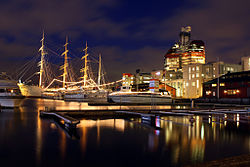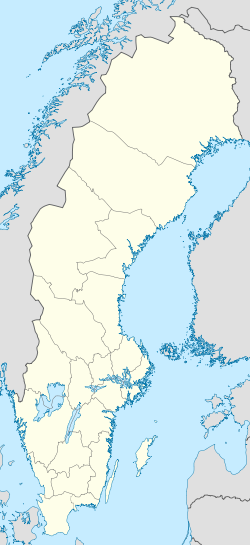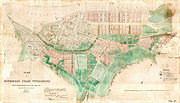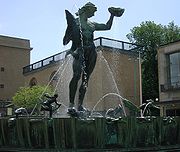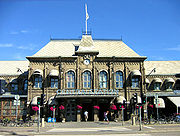
Gothenburg
Background to the schools Wikipedia
The articles in this Schools selection have been arranged by curriculum topic thanks to SOS Children volunteers. SOS Children has looked after children in Africa for forty years. Can you help their work in Africa?
| Gothenburg Göteborg |
|||
|---|---|---|---|
|
|||
|
|
|||
| Coordinates: 57°42′N 11°58′E Coordinates: 57°42′N 11°58′E | |||
| Country | Sweden | ||
| Province | Västergötland and Bohuslän | ||
| County | Västra Götaland County | ||
| Municipality | Gothenburg Municipality, Härryda Municipality, Partille Municipality and Mölndal Municipality |
||
| Charter | 1621 | ||
| Government | |||
| • Mayor | Anneli Hulthén | ||
| Area | |||
| • City | 450 km2 (170 sq mi) | ||
| • Water | 14.5 km2 (5.6 sq mi) 3.2% | ||
| • Urban | 198.16 km2 (76.51 sq mi) | ||
| • Metro | 3,717 km2 (1,435 sq mi) | ||
| Population (2009) | |||
| • City | 507,330 | ||
| • Density | 1,100/km2 (2,900/sq mi) | ||
| • Urban | 510,491 | ||
| • Urban density | 2,600/km2 (6,700/sq mi) | ||
| • Metro | 917,984 | ||
| • Metro density | 250/km2 (640/sq mi) | ||
| Time zone | CET ( UTC+1) | ||
| • Summer ( DST) | CEST ( UTC+2) | ||
| Website | www.goteborg.se | ||
Gothenburg ( Swedish: Göteborg; pronounced [jœteˈbɔrj]) is the second-largest city in Sweden (after Stockholm) and the fifth-largest amongst the Nordic countries. Situated on the south-west coast of Sweden, the city proper has a population of 507,330 with 510,491 in the urban area and total of 917,984 inhabitants in the metropolitan area.
The City of Gothenburg was founded in 1621 by King Gustavus Adolphus of Sweden. It is situated by the sea at the mouth of Göta Älv—the river running through the city—and is the largest sea port of the Nordic countries.
Gothenburg is also home to many students, as the city includes both the University of Gothenburg and Chalmers University of Technology. Volvo Cars was founded in Gothenburg in 1927.
Name
The city was named after the Geats (Swedish: Götar varied: Geatas, Gautar, Goths, Gotar, Gøtar, Götar), the inhabitants of Gothia, now southern Sweden—i.e. "Defense of the Geats". The river on which the city sits is the Göta Älv or Gothia River. Göta borg or Gothia Fortress is the fort on the Göta River, built to protect the port, which was created to be Sweden's commercial window to the west.
In Dutch, Scots and English—all languages with a long history of being spoken in the trade and maritime-oriented city—the name Gothenburg has traditionally been used for the city. The French form of the city name is Gothembourg. Gottenburg can also be seen in some older English texts. These traditional forms are now sometimes replaced with the use of the Swedish Göteborg, for example by the Göteborg Opera, Göteborg Ballet, Göteborg International Film Festival, and by the city itself (in English, the City of Göteborg). The U.S. Navy also refer to the city in English as Göteborg. Effective February 1, 2008, however, Göteborgs universitet, previously designated as Göteborg University in English, changed to the University of Gothenburg. Other old variations in Swedish are Götheborgh, and the more common, Götheborg. One English text written in the late 15th century says the name as "Guthaeborg".
History
In the 16th and 17th century, the configuration of Sweden's borders made Gothenburg strategically important as the Swedish gateway to the west, lying on the west coast in the narrow area between the territories of Denmark-Norway. After several failed attempts, Gothenburg was successfully founded in 1621 by King Gustavus Adolphus (Gustaf II Adolf). The city was heavily influenced by the Dutch. Dutch city planners were contracted to build the city as they had the skills needed to build in the marshy areas around the city. The town was planned after Dutch cities to have canals like Amsterdam, and the blueprint for the canals of Gothenburg are actually the same as those used for Jakarta. The Dutchmen initially won political power and it was not until 1652, when the last Dutch politician in the city's council died, that the Swedes acquired political power over Gothenburg. During the Dutch period the town followed Dutch town laws and there were propositions to make Dutch the official language in the town. Heavy city walls were built during the 17th century. These city walls were torn down after about 1810, because the development of cannons made such walls less valuable as a defense.
Along with the Dutch, the town also was influenced by the Scottish, who came to settle in Gothenburg. Many became people of high profile and one such person was William Chalmers, who donated his fortunes to create what later became Chalmers University of Technology. The Scottish influence can still be felt in Gothenburg in present day as names like Glenn and Morgan, which in the rest of Sweden usually are rare, are not uncommon in Gothenburg, and the use of a Scottish sounding "r" in the local dialect.
The Gothenburg coat of arms was based on the lion of the coat of arms of Sweden, symbolically holding a shield with the national emblem, the Three Crowns, to defend against its enemies.
In the Treaty of Roskilde (1658) Denmark-Norway ceded the then Danish province Halland, to the south, and the Norwegian province of Bohus County or Bohuslän to the north, leaving Gothenburg in a less exposed position. Gothenburg was able to grow into an important port and trade centre on the west coast thanks to the fact that it was the only city on the west coast that was granted, together with Marstrand, the rights to trade with merchants from other countries.
In the 18th century, fishing was the most important industry. However, in 1731 the Swedish East India Company was founded, and the city flourished due to its foreign trade with highly profitable commercial expeditions to Asian countries.
The harbour developed into Sweden's main harbour for trade towards the west, and with the Swedish emigration to North America increasing, Gothenburg became Sweden's main point of departure. The impact of Gothenburg as a main port of embarkation for Swedish emigrants is reflected by Gothenburg, Nebraska, a small Swedish settlement in the United States.
With the 19th century, Gothenburg evolved into a modern industrial city that continued on into the 20th century. The population increased tenfold in the century, from 13,000 (1800) to 130,000 (1900). In the 20th century major companies that developed included SKF (est. 1907) and Volvo (est. 1926).
In more recent years however, the industrial section has faced a recession, which has spurred the development of new sectors such as increased merchandising, tourism and cultural and educational institutions.
In 2001, major protests occurred in the city during the EU summit and the visit by U.S. president George W. Bush.
Geography
Gothenburg is located on the west coast, in Southwestern Sweden, approximately half way between the capitals Copenhagen, Denmark, and Oslo, Norway. The location at the mouth of the river Göta älv, which feeds into Kattegatt, an arm of the North Sea, has helped the city grow in significance as a trading city. Due to the Gulf Stream, the city has a mild climate and quite a lot of rain.
The archipelago of Gothenburg consists of rough, barren rocks and cliffs, which also is typical for the coast of Bohuslän.
The Gothenburg Metropolitan Area extends to the municipalities of Ale, Härryda, Kungälv, Lerum, Mölndal, Partille, Stenungsund, Tjörn, Öckerö in Västra Götaland County, and Kungsbacka in Halland County.
Climate
Gothenburg has an oceanic climate according to Köppen climate classification. Despite its high northern latitude, temperatures are quite mild throughout the year and much warmer than places in similar latitude, or even somewhat further south, mainly because of the moderating influence of the warm Gulf Stream. During the summer, daylight extends 17 hours, but lasts only around 7 hours in late December.
Summers are warm and pleasant with average high temperatures of 20 to 21 °C (68 to 70 °F) and lows of 11 to 13 °C (52 to 55 °F), but temperatures of 25–30 °C (77–86 °F) occur on many days during the summer. Winters are cold and windy with temperatures of around -4 to 3 °C (25 to 37 °F), even though it rarely drops below −10 °C (14 °F). Winters are much warmer than other places in same latitude, and are not colder than either Canada and most of northern United States.
Precipitation is regular but generally moderate throughout the year. Snow mainly occurs from January to March. Snow cover occurs but usually does not remain very long.
Typical temperatures and precipitation for each month:
| Climate data for Göteborg | |||||||||||||
|---|---|---|---|---|---|---|---|---|---|---|---|---|---|
| Month | Jan | Feb | Mar | Apr | May | Jun | Jul | Aug | Sep | Oct | Nov | Dec | Year |
| Source: World Weather Information Service | |||||||||||||
Culture
The sea, trade and industrial history of the city is evident in the cultural life of Gothenburg. The greatest attraction in the city is the amusement park Liseberg (see Sites of interest). Another fact related to the industrial heritage of the city is that many of the cultural institutions, as well as hospitals and the university, were created thanks to donations from rich merchants and industrialists, for example the Röhsska Museum.
There are many free theatre ensembles in the city, besides institutions like Gothenburg City Theatre, Backa Theatre (youth theatre), and Folkteatern. On December 29th, 2004, the Museum of World Culture was opened in Gothenburg, located near Korsvägen.
The Gothenburg Film Festival, held each year, is the largest film festival in Scandinavia. Similarly, the Gothenburg Book Fair, held every year in September, is the largest such event in Scandinavia.
Citing the Financial Crisis, in a move set to disappoint many in the Asia-Pacific region, IFLA has announced that Gothenburg will host the 2010 World Library and Information Congress, previously to be held in Brisbane, Australia.
Architecture
There are very few houses left from the 17th century when the city was founded, since all but the military and royal houses were built of wood. One example is Skansen Kronan.
The first major architecturally interesting period is the 18th century when the East India Company made Gothenburg an important trade city. Imposing stone houses with a Classical look were erected around the canals. One example from this period is the East India House, which today houses Gothenburg’s City Museum.
In the 19th century, the wealthy bourgeoisie begun to move outside the city walls which had protected the city when the Union of Denmark and Norway was still a threat. The style now was an eclectic, academic, somewhat over decorated style which the middle-class favoured. The working class lived in the overcrowded city district Haga, in wooden houses.
In the 19th century the first important town plan after the founding of city was created, which led to the construction of the main street, Kungsportsavenyn. The perhaps most significant type of houses of the city, Landshövdingehusen, were built in the end of the 19th century; three storey-houses with the first floor in stone and the other two in wood.
A very important period in the architectural history of the city was the early 20th century, when the National Romantic style dominated. Among the many monumental building erected the Masthugget Church can be mentioned.
And in the beginning of the 1920s, when the city celebrated its 300th anniversary, the Götaplatsen square with its Neo-Classical look was built.
After this the predominant style in Gothenburg and rest of Sweden was Functionalism which especially dominated the suburbs like Västra Frölunda and Bergsjön. The prominent Swedish functionalist architect Uno Åhrén served as the city planner here from 1932 through 1943. In the 1950s the big stadium Ullevi was erected when Sweden hosted the 1958 FIFA World Cup.
The modern architecture of the city is being formed by such architects as Gert Wingårdh who started as a Post-Modernist in the 1980s.
A further remarkable construction is Brudaremossen TV Tower, one of the few partially guyed towers in the world.
Characteristic buildings
The Gothenburg Central Station is in the heart of the city, just next to Nordstan and Drotningtorget. The building has been renovated and expanded numerous times since the grand opening in October 1858. In 2003 a major reconstruction was finished which brought the 19th century building in to the 21th century expanding the capacity for trains, travellers and shopping. Not far from the centralstation is Skanskaskrapan, or more common known as "The Lipstick". It's 86 meters high with 22 floors and coulored in red-white stripes. The skyscraper was designed by Ralph Erskine and built by Skanska in the 1980's as the headquarter for the company.
By the shore of Göta Älv is the Gothenburg Opera. It was done in 1994. The architect Jan Izikowitz was inspired by the landscape and described his vision as "Something that makes your mind float over the squiggling landscape like the wings of a seagull. The shape is inspired by the impressive landscape with the light and openness, to the concrete technical constructions of the port; the floating grace of the bridges; the obvious frame made from the strength, softness and grace of the hull of a ship, the seagull's wings and the flawless streamlined shape of a sail."
Feskekôrka, or Fiskhallen, is a fishmarket by the Rosenlundskanalen in the heart of Gothenburg. Feskekôrkan was opened on November 1 1874 and the name comes from being compared with a church.
Music
Gothenburg has a rich music life—the Gothenburg Symphony Orchestra is the best known when it comes to classical music. Gothenburg also was the birthplace of the Swedish composer Kurt Atterberg. Bands like The Soundtrack of Our Lives and Ace of Base are well known pop representatives of the city. There is also an active indie scene. For example, the musician Jens Lekman was born in the suburb of Angered and named his 2007 release Night Falls Over Kortedala after another suburb ( Kortedala). Other internationally acclaimed indie artists include the electro pop duos Studio, The Knife, and Air France, dance group The Tough Alliance, songwriter José González and pop singer El Perro Del Mar as well as genre bending quartet Little Dragon fronted by vocalist Yukimi Nagano.
The city is also noted for being the centre of the heavy metal subgenre melodic death metal (sometimes even called "The Gothenburg sound"). Gothenburg metal is distinct to the traditional death metal due to its mixture of melody, harmony and extensive guitar solos. Often, keyboards and clean singing are incorporated (instead of using the traditional death metal growl vocal style). Gothenburg's own commercially successful At the Gates, In Flames and Dark Tranquillity are credited with pioneering this melodic style, although first made by Michael Amott of Arch Enemy, Spiritual Beggars, ex- Carcass and ex- Carnage. Another well known band of the Gothenburg scene is Soilwork, although they hail from Helsingborg. Progressive power metal band Evergrey also originate from the city as do power metal bands Hammerfall and Dream Evil.
The Metaltown Festival is a two day festival featuring heavy metal music bands, held in Gothenburg. It has been arranged annually since 2004, taking place at the Frihamnen venue. The most recent festival, 26–27 June 2009, included bands such as Marilyn Manson, Slipknot, Opeth, Napalm Death, and Disturbed.
Food and drink
Gothenburg, with its location by the sea, is famous for the quality and variety of its seafood dishes. Various fish restaurants exist in the city, from low-class shacks to world-class eateries. The city also has a number of star chefs – over the past decade, seven of the Swedish Chef of the Year Awards have been won by Gothenburgers. A popular place to buy fish ingredients is the Feskekôrka ("Fish Church"); an indoor fish market which got its name from the building's resemblance to a Gothic church. Five Gothenburg restaurants have a star in the 2008 Michelin Guide: 28 +, Basement, Fond, Kock & Vin and Sjömagasinet.
Sports
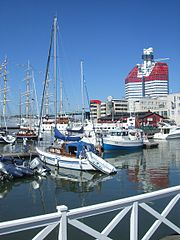
As in all of Sweden, a variety of sports are followed, including but not limited to ice hockey, football, basketball, and team handball. There is a varied amateur and professional sports clubs scene. Gothenburg is the birthplace of football in Sweden as the first football match in Sweden was played there in 1892. The city's three major clubs, IFK Göteborg, Örgryte IS and GAIS share a total of 34 Swedish Championships between them. IFK has also won the UEFA Cup twice. Other notable clubs include BK Häcken (football), Pixbo Wallenstam IBK ( floorball), multiple national team handball champion Redbergslids IK, and three time national ice hockey champion Frölunda HC, Gothenburg has also a professional Basketball team Gothia Basket.
The city's most notable sports venues are Scandinavium (ice hockey), and Nya Ullevi (multisport) and the new-built Gamla Ullevi (football).
Gothenburg has hosted a number of international sporting events including the 1958 FIFA World Cup, the 1983 European Cup Winners' Cup Final, the 1992 European Football Championship, the 1993 and the 2002 World Men's Handball Championship, the 1995 World Championships in Athletics, the 1997 World Championships in Swimming (Short track), the 2002 Ice Hockey World Championships, the 2004 UEFA Cup final, the 2006 European Championships in Athletics, and the 2008 World Figure Skating Championships. Annual events held in the city are the Gothia Cup and the Göteborgsvarvet.
Gothenburg will host the XIII FINA World Masters Championships 2010. Diving, swimming, synchronized swimming and open water competitions will take place from July 28 to August 7. The water polo events will be held on the neighboring city of Borås.
Economy
Due to the Gothenburg's advantageous location in the centre of Scandinavia, trade and shipping have always played a major role in the city's economic history, and they continue to do so. Gothenburg port has come to be the largest harbour in the whole of Scandinavia.
Apart from trade, the second pillar of Gothenburg has traditionally been manufacturing, and industry which significantly contributes to the city's wealth. Major companies operating plants in the area include SKF, Volvo, and Ericsson. Volvo Cars is the largest employer in Gothenburg, not including jobs in supply companies. The blue collar industries which have dominated the city for long are still important factors in the city's economy, but they are being gradually replaced by high tech industries.
Banking and finance are also important trades as well as the event and tourist industry.
Historically, Gothenburg was home base of the 18th century Swedish East India Company and were from the founding of the city until the late 1970s a world leading city in ship building with shipyards as Eriksbergs Mekaniska Verkstads AB, Götaverken, Arendalsvarvet and Lindholmens varv.
Government
Demographics
Gothenburg, like most Swedish metropolitan areas, has a large immigrant population. According to Statistics Sweden in 2005, there are 108,480 immigrants resident in Gothenburg, which is about 25% of the population, out of which 10% are from Finland and 9% from Iran. The Iranian population, as well as other immigrants from the Middle East (notably Iraq) and Somalia is concentrated in Angered (most notably Hjällbo and Hammarkullen), other suburbs in the north east ( Bergsjön) and Biskopsgården, while other immigrants from Scandinavia, Southern Europe (notably Croatia, Bosnia and Herzegovina, Macedonia, Portugal, Italy and Greece) and Eastern Europe are far less segregated.
Education
Gothenburg has two universities, both of which started off as colleges founded by private donations in the 19th century. The University of Gothenburg has approximately 25,000 students and is one of the largest universities in Scandinavia and one of the most versatile in Sweden. Chalmers University of Technology is a well known university located in Johanneberg 2 km south of inner city, lately also established at Lindholmen in Norra Älvstranden, Hisingen.
There are also four folk high schools (Arbetarrörelsens Folkhögskola i Göteborg, Folkhögskolan i Angered, Göteborgs Folkhögskola, and Kvinnofolkhögskolan).
Gothenburg has some 25-30 high schools. Four of the more notable schools are Schillerska gymnasiet, Donnergymnasiet, Hvitfeldtska gymnasiet, Burgårdens Utbildningscentrum and Göteborgs Högre Samskola. There are also some high-schools connected to big Swedish companies. One is SKF Technical high-school (belonging to SKF) and Gothenburg's technical high-school (belonging to Volvo).
Points of interest
Gothenburg is a popular destination for tourists on the Swedish west-coast, and offers a number of cultural and architectural highlights.
The main boulevard is called Kungsportsavenyn (commonly known as Avenyn, "The Avenue"). It is about one kilometre long and starts at Götaplatsen — which is the location of the Gothenburg Museum of Art, the city's theatre, the city library as well as the concert hall— and stretches out all the way to Kungsportsplatsen in the old city centre of Gothenburg, crossing a canal and a small park. The Avenyn was created in the 1860s and 1870s as a result of an international architecture contest, and is the product of a period of extensive town planning and re-modelling. Avenyn has Gothenburg's highest concentration of pubs and clubs.
Scandinavia's second largest shopping centre, Nordstan, is located in central Gothenburg. Gothenburg's Haga district is known for its picturesque wooden houses and its cafés.
The Gothenburg Opera house was inaugurated in 1994, and is an architectural landmark situated right next to the Göta älv river. Museums include the Gothenburg Museum of Art, Göteborgs Konsthall, Röhss Museum, and several museums of sea and navigation history, natural history, the sciences, and East India. The Museum of World Culture was inaugurated in 2004. Aeroseum, close to the Göteborg City Airport, is a unique aircraft museum in a former military under ground Air Force base.
The Göteborg Botanical Garden is considered to be one of the most important botanical gardens in Europe with three stars in the French Guide Rouge. Next to the botanical garden is Gothenburg's largest park, Slottsskogen, where the Natural History Museum (Naturhistoriska Museet) is located. The park is also home to the city's oldest observatorie and a zoo.
The amusement park Liseberg is located in the central part of the city. Liseberg is Scandinavia's largest amusement park by number of rides, and the most popular attraction in Sweden by number of visitors per year (>3 millions). Located near Liseberg is a science discovery centre named Universeum.
One of Gothenburg's most popular natural tourist attractions is the Southern Gothenburg Archipelago, which is a set of many picturesque islands that can be reached by ferry boat. Within the archipelago Älvsborg Fortress, Vinga and Styrsö islands are popular places to visit.
The Gunnebo House can be seen South of Gothenburg, in Mölndal. It was built in a neoclassical architecture in the end of the 18th century.
Transportation

Air
Gothenburg-Landvetter Airport is an international airport serving the Gothenburg region in Sweden. With 4.3 million passengers in 2006 it is Sweden's second-largest airport. It is operated by the Swedish Civil Aviation Administration (Luftfartsverket). It has connections with about 40 scheduled destinations, and is located 20 km east of Gothenburg.
Gothenburg's second international airport is Gothenburg City Airport formerly known as Säve Flygplats and Sweden's 7th largest airport. It is located within the borders of Gothenburg Municipality, about 15 km northwest of the city centre. In 2008, more than 850,000 flew from City Airport. In addition to commercial airlines, the airport is also operated by a number of rescue services, including the Swedish Coast Guard, and is used for other general aviation.
Sea
The Swedish company Stena Line operates between Gothenburg/ Fredrikshavn in Denmark and Gothenburg/ Kiel in Germany.
The "England ferry" (Englandsfärjan) to Newcastle over Kristiansand (run by the Danish company DFDS Seaways) ceased at the end of October 2006, after being a Gothenburg institution since the 19th century. DFDS Seaways' sister company, DFDS Tor Line, continues to run scheduled freight ships between Gothenburg and several English ports, and these have limited capacity for passengers and their private vehicles. There are also freight ships to North America and East Asia.
Rail and intercity bus
Other major transportation hubs are Centralstationen ( Gothenburg Central Station) and the Nils Ericson Terminal with trains and buses to various destinations in Sweden, as well as connections to Oslo and Copenhagen (via Malmö).
Freight
Gothenburg is a logistic centre, with transports by train and truck from Sweden and Norway to Gothenburg harbour which is by far the largest port in Scandinavia with a cargo turnover of 36.9 million tonnes a year (2004).
Public transport
With over 80 km of double track the Gothenburg tram is the largest tram/light rail network in Scandinavia. The bus network, however, is almost as important. There are also some boat and ferry services. The lack of a subway is due to the soft ground on which Gothenburg is situated. Tunneling is very expensive in such conditions. There is also a commuter rail in Gothenburg servicing nearby some nearby cities and towns.
